
Pendulous Sedge, Carex pendula is an extremely widespread plant found throughout most of the United Kingdom. It is known to grow as far north as Denmark and Sweden up 58oN latitude, and as far south as West Africa and the Middle-East. It has been reported to be spreading across North America and has been introduced to New Zealand.
Pendulous Sedge – Habitat and Identifying Features
Pendulous sedge is part of the sedge family, Cyperaceae. The flowering bodies of the pendulous variety, like its name, hang down and swing like pendulums in the wind. It is found in clumps in damp woodland often on heavy clay soil. The plants stems grow to around 1m (3ft) long, but can grow up to 3.5m (10ft). Its leaves are long and slim, ranging from green to light yellow depending on the time of year.
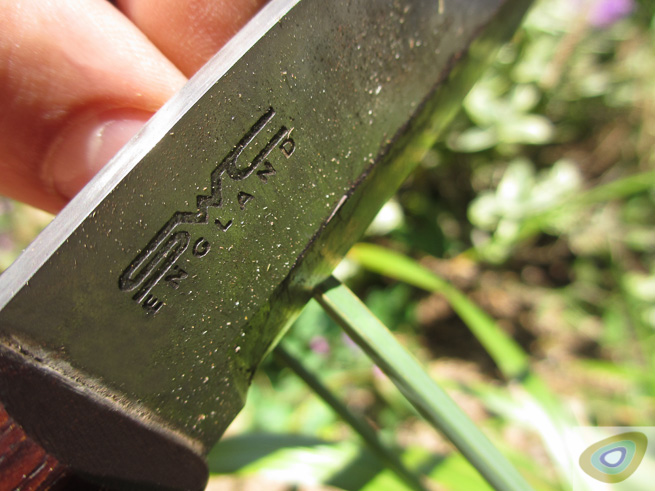
There is a fail safe way to tell a Sedge from other grasses. This is by its stem cross section. It has a distinct triangular shape. By cutting the stem carefully with a knife it is possible to see this identifying feature, and confirm the species.
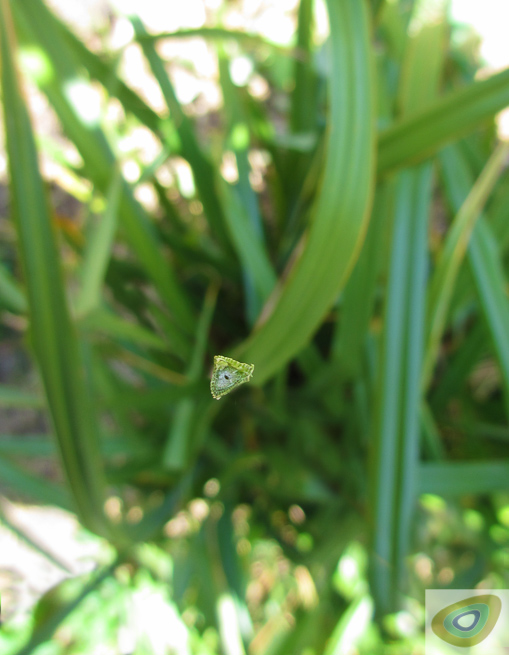
Pendulous Sedge – Wilderness and Survival Food
Pendulous sedge is a great wilderness and survival food to know about. Once located it is often found in large quantities and when ripe can be quickly gathered. Sedges are one of the wild grains not prone to Black Ergot Fungus, of which the most common is Claviceps purpurea.
Claviceps purpurea has been found on many grass species including wheat and barley and reports exist that if the fungus is eaten by mammals, including humans, it can cause Ergotism. This has been described as causing an affliction known as Saint Antony’s Fire. Some of the symptoms include burning leg pains, hallucinations, muscle spasms and convulsions.
Ergot fungus can be identified as black or dark purple bodies growing out of grains, usually larger than most grains apart from wheat. As stated above, the good thing about pendulous sedge is that it does not become infected by Ergot.
A word of warning: Wild grasses can contain black ergot fungus. Remember to follow the rule for foraging – IF IN DOUBT LEAVE IT OUT!

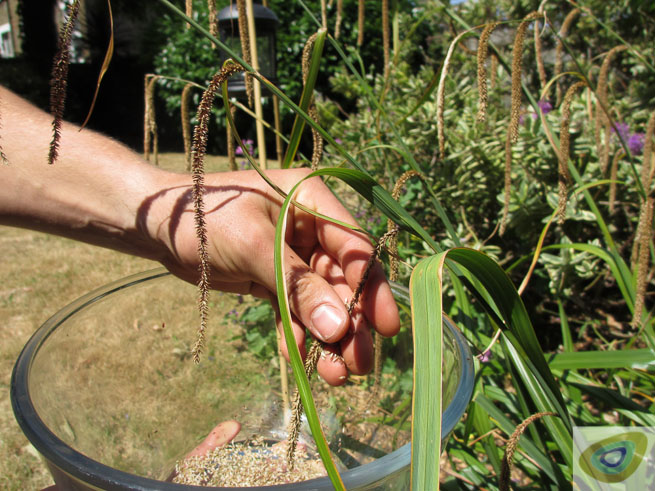
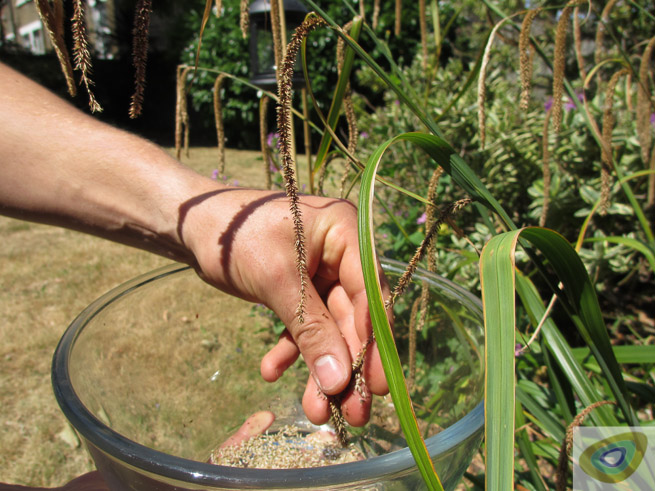
Processing The Grain Of Pendulous Sedge
Like wheat, barley or rice, pendulous sedge needs to be processed in order to make it palatable and in a form that our digestive systems can break down. This process comes in two parts, winnowing and milling.
First the sedge must be ripe and ready to pick. Look for a light brown colour, if the sedge looks green it is not ripe.
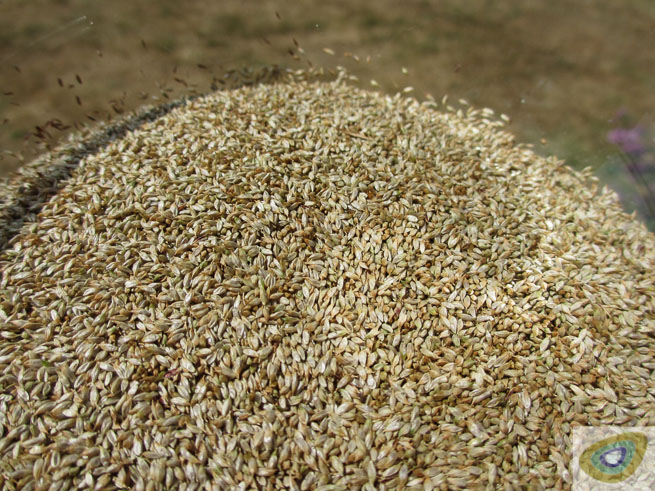
Winnowing is the ancient agricultural process of separating the grain (the fruiting body) from the chaff (the protective casing) commonly utilising the movement of air. Over the centuries many methods and tools for winnowing have been developed. As agriculture has become more widespread, the methods for winnowing on a large scale have become more mechanised.
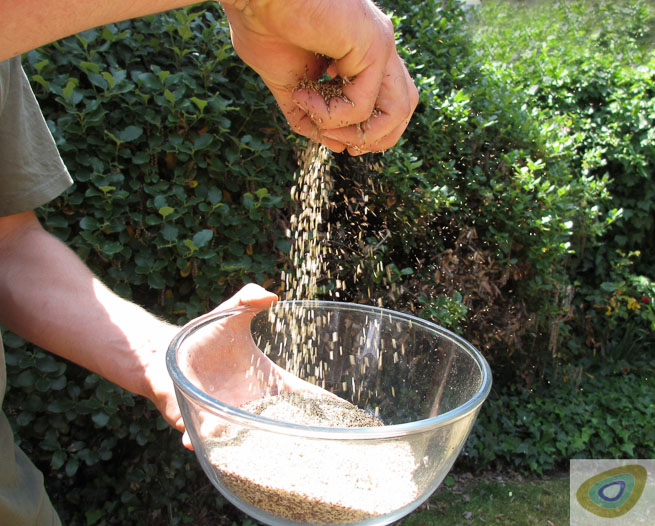
For the purpose of winnowing your own sedge, a light breeze or your own breath work well. After some experiments I found that milling the sedge a little first helped to separate the grain from the chaff during the winnowing stage. In Africa, large wooden mortar and pestles are still used to de-hull grains.
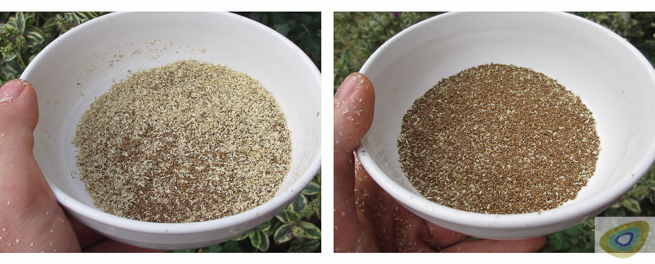
Milling is the second process, and like winnowing is another ancient agricultural method. Traditionally milling involves two stones ñ a lower stationary stone called a quern stone and an upper mobile stone called a hand stone. I used a mortar and pestle to recreate this process, but two suitable stones can be used in the woods.
This process needs patience and elbow grease. You may need to repeat the milling and winnowing stages a few times. After a few hours I had 600 grams of medium fine sedge flour.

How The Sedge Crumbles
Well, what’s the point in going to all the effort of collecting, grinding, winnowing and milling if you’re not going to do anything with your sedge flour? I decided to take advantage of the time of year and make a wild blackberry and apple crumble.
Near the Frontier Bushcraft course site in East Sussex during the mid to late summer, huge quantities of blackberries and wild apples can be foraged for.

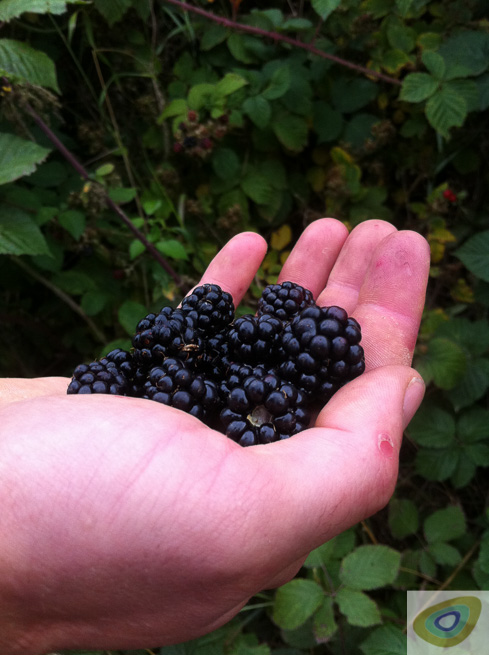
I wanted to perfect the recipe before making it in the woods, so for the first round I cooked in my kitchen (watch out Frontier team you’re the guinea pigs next time). All the main ingredients for this recipe can be foraged for at the same time of year. The ingredients that need to be brought with you are a little sugar and a little butter, both of which I take with me when hiking in the woods.
The Ingredients
For the crumble
- 220g of Pendulous Sedge flour
- 60g sugar
- 60g unsalted butter
For the fruit compote
- 300g wild apples
- 115g blackberries
- 30g sugar
- 30g unsalted butter
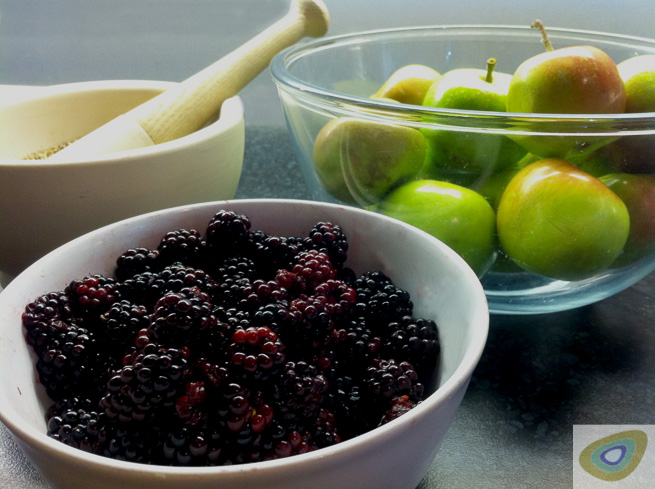
The Recipe
1. Tip the sedge flour and sugar into a large bowl or billy can. Add the butter in small lumps to the mixture; rub the butter into the flour using your fingertips to make a light breadcrumb texture. Do not overwork it or the crumble will become heavy. Sprinkle the mixture evenly over a baking sheet and bake for 15 minutes or until lightly coloured. Or using the lid of a billy can or an insert propped up towards a roasting fire you can achieve the same results, don’t forget the 5 second rule for cooking by a fire.
(The five second rule: Hold the back of your hand towards the fire alongside whatever you are baking or roasting, and count to five. If you get past five and your hand isn’t hot it needs to be closer; if you get to three and your hand is on fire, you’re probably a bit close.)
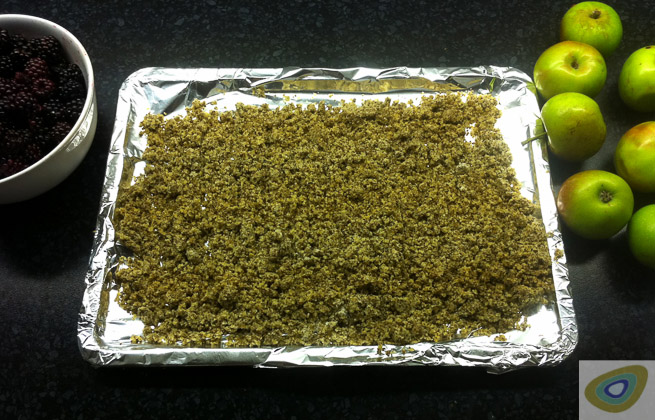
2. While the crumble is baking, peel, core and cut the apples into 2cm (1″) cubes. Put the butter and sugar in a medium pan or billy can and melt together over a medium to low heat. Cook for 3 minutes until the mixture turns to a light caramel. Stir in the apples and cook for 3-5 minutes. Add the blackberries, and cook for 3 minutes more. Cover, remove from the heat, and then leave for 2-3 minutes to continue cooking in the warmth of the pan or billy can, not too close to the fire.
3. To serve, add the crumble to the compote, then reheat alongside the fire for 10-15 minutes, turning the billy can every few minutes to give an even heat. Next forage for some vanilla ice cream and serve.
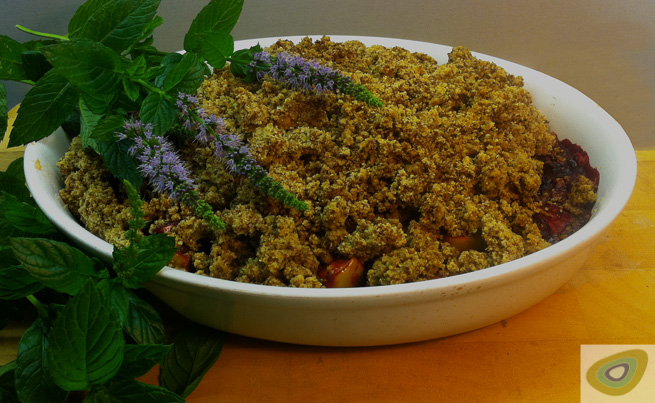
My girlfriend’s thoughts about the Crumble: “Processing the sedge made me appreciate the lengths at which our ancestors had to go through to get their food. Foraging for the ingredients made the experience incredibly honest, and I donít know if it was the process or the freshness of the ingredients that made the sedge crumble taste so delicious!”
Pendulous Sedge is a rewarding plant to know and use: easy to identify, plentiful when found, free from dangerous Ergot Fungus, simple to process, but most importantly delicious and nutritious!
Like with most foraged resource I go to great efforts to preserve and encourage the resources I use. By re-sowing some of the sedge seeds I collected when foraging, I hope to increase the number of plants in the areas I forage and not to denude a finite resource.

Have you made any interesting dishes with pendulous sedge? Or crumbles with wild fruit? Let us know in the comments below.
Latest posts by Henry Landon (see all)
- A Springtime Feast: Cooking Up A Treat In The Woods - April 22, 2020
- Getting Fit For Your Next Adventure - April 10, 2020
- The Value of Carrying a Rope While Hiking - June 6, 2017

Gandalf
Great article, got to try that recipe and technique.
Thanks for the info.
Henry
Hi Gandalf,
Glad you liked the article, a very rewarding technique with a tasty result.
Do have a go, thanks for reading and commenting,
All the best,
Henry
Chris Allen
Pendulous sedge is one of the edibles I’ve never come across on my wanderings. I feel somehow incomplete. Great article though, really makes my mouth water just thinking about it. I am now more determined to find some sedge. Thanks.
Henry
Hi Chris,
Pendulous sedge is a great plant to know about, wide spread and common. Now you know what to look for I’m sure you’ll see it around.
I’m glad you liked the article, it is a mouth watering concoction.
All the best,
Henry
Roy Henshall
Great article, will Pendulous Sedge keep for a year or so in an airtight bag/jar.
THANKS Paul
HEDGEY
Henry
Hi Roy,
I’m really glad you enjoyed the article. In response to your question, once winnowed and milled the sedge should maintain its freshness for a while, and can be treated like flour i.e. store in a cool dry place.
As far as the unprocessed seeds go, I’m not sure if they will keep for a year, this may depend on the moisture content in the bag which could make the seeds go mouldy. Keep an eye out for condensation on the inside of the bag.
Thanks for the comment and interesting question,
Henry
Ian Shankland
Thanks Henry, an instructive and useful article. Got me salivating, Ian
Henry
Hi Ian,
Your very welcome I’m glad the end product appealed to you, it’s really worth a having a go at making. The blackberries and apples are in abundance right now, the sedge is coming to an end but is still available.
Thanks for reading and commenting.
Best wishes,
Henry
Lars
Great article. Looks alot better than some of the roots and berries we had to use in the Jungle survival training center. I’ll have to keep an eye out for sedge now in my wanderings. Is it in the USA desert southwest? Thanks again. Lars.
Henry
Hi Lars,
Thanks for the comment, I’m pleased you liked the article. I can imagine that it would taste better than some of the survival training centre delicacies 🙂
Having time to experiment with wild foods when not needed to rely on them is a luxury.
There are reports of Carex Pendula in Virginia but I cant find anything about the southwest, let us know if you do find any.
Best wishes,
Henry
Austin Lill
Hi Henry, Nice little piece. I guess it’s no relative, but I wonder if the sedge seeds are similar to plantain seeds in nutrition etc…Just as satisfying to collect as sedge!
Henry
Hi Austin,
Good to hear from you, glad you like the article. I’m not sure of the exacts nutritional content comparison of pendulous sedge versus members of the plantain family, but your right plantain seeds are defiantly worth collecting.
The collection method of Broad-leaved and Ribwort Plantain is very similar to that of sedge and is a good source of nutrition.
Thanks for the comment, best wishes,
Henry
John F
Great article, Henry, with more info on everything from picking to baking than anywhere else I’ve found, thanks. Any idea why these kinds of seeds are usually recommended to be milled into flour? Do you know if they could be just winnowed and then roasted or boiled like rice? It would reduce some of the work.
Henry
Hi John,
Thanks for your kind praise. I’m glad it its useful. As far as why it is recommended to mill the sedge seeds – our digestive system struggles to break down the outer husk of the seeds, milling breaks this barrier down allowing us to gain the maximum energy from the plant. As for boiling the seeds it’s not something I’ve tried, but it might work. Let me know if you try it.
Cheers,
Henry
John F
Thanks for your reply. Surely the “outer husk” is what you’d winnow away – but maybe there’s another inner husk? I haven’t found any further info on this, but I keep looking at a large specimen outside my kitchen window, which is ripe for some experiments. I’ll let you know how they go. I’ll try roasting them a little and at least see if they taste good. I’ve got masses of this stuff coming up everywhere in the garden, which isn’t particularly a problem to dig out while they’re young, and they look much like the grass where they come up in the lawn, but this is very intriguing. When I started an allotment a few years ago, I searched for staple seed crops with good protein and carbohydrate content to grow in the north of Britain, to get as much out of the land as we could and make a change from spuds. I tried quinoa, but that didn’t separate from the stems as easily as I expected, and then would have taken a lot more work to clean (it has a saponin on the surface, great for stopping the birds eating it, but it tastes bitter) and mill into flour. Although you can eat it as seeds, we didn’t really like the texture of it much and, once you’ve washed all the soapy chemicals off it, it’s wet and needs drying all over again! Pendulous sedge might make an addition to our allotment crops.
Hester
Hello Henry. Great site! I stumbled across this because I am in the process of trying to persuade a lodge development in our tiny village from planting hundreds of pendulous sedge as part of their landscaping. It is, in cool, damp areas, an absolute thug. It is classed as an invasive and reportable weed in parts of the US and has also come to the attention of the National Trust because it is beginning to choke up river edges and damp meadows, much like Himalayan Balsam (one of the introduced Impatiens species). To the person who thought about putting it into their allotment, I hope they didn’t! I had no idea you could eat it, as I know you can the seeds of the balsam (properly prepared). Please eat as much as possible and don’t feel the need to sow the seeds to make more! Happy foraging.